The Desert War: Gaming WW2 In North Africa Part Four – Turning The Tide
September 7, 2015 by crew
For the past three weeks, we have reviewed (and more importantly, gamed) our way through some of the more decisive engagements of the Desert War, fought primarily in the deserts of North Africa during World War II. For those just joining us, our progress thus far has been presented in Parts One, Two, and Three of the series.
But, after two years of ebb and flow, attack and counter-attack, a crisis point has been reached in the late summer of 1942. Having been thrown back halfway across Egypt, the Allies can retreat no further. Having exhausted their supplies and reinforcements, the Axis can wait no longer. The Allies are out of space, the Axis is out of time. One way or another, a decision will now be made at a tiny desert railroad town...called El Alamein.
A Decisive Push
As we saw in Part Three, “Panzergruppe Afrika” decisively defeated the British and their Commonwealth allies at the Battle of Gazala. Rommel was thus able to overrun Tobruk (which had held out for 240+ days the last time the Germans had been here), and push the Allies back into Egypt. The British attempted to make a stand at Mersa Metruh, but were outflanked and defeated again. This time the retreat took them all the way back to El Alamein.
In direct violation of orders, Rommel went after them. His superiors knew this was a bad idea, to push this deep into Egypt against numerically superior forces would badly overstretch his already-vulnerable supply lines. The British knew it, too, and were using every weapon they had to strike at these supply routes.
One of these weapons was the Long Ranged Desert Group (LRDG), which was about to carry out their most famous raid …
The Long Range Desert Group
“Operation Caravan” was an LRDG strike at the Axis airfield at Barce, on the northern coast of Libya. It was part of a larger series of commando-type operations aimed at disrupting Panzerarmee Afrika’s lines of communication and supply, involving the SAS, British Commandos, the Royal Marines, the Royal Navy, and even a battalion of line infantry.
Interestingly, the Italians largely defeated all of these operations except Operation Caravan. The operation is also unusual because the LRDG was usually deployed as a reconnaissance force rather than a “commando strike” unit. Experts in desert navigation and survival, they often took the SAS to their targets, rather than strike the targets themselves. But, as they certainly showed at Barce, the LDRG could “get messy” with the best of them.
Ironically, the LRDG’s attack on Barce was not a complete surprise as they’d been spotted some time ago by the Italian Air Force. However, the Italians at the airfield did not expect the attack to come straight off the main road, “through the front door,” especially since one of their own columns had just passed up that same road. These Italians and the LRDG actually passed each other in the night, going so far as to wave hello. Such was the “fog of war” in the desert, especially in darkness.
The raid was a success, with just four of the LRDG attackers wounded. Accounts vary on how much damage they did, ranging from between 16 and 32 aircraft destroyed. Four LRDG vehicles had been wrecked and so many of the men had to WALK across the desert to other LRDG rendezvous points. They were attacked from the air and harried by Italian counter-attacks, while some LRDG raiders were captured.
This just goes to show that, despite the movies, “special forces” are just as fragile as any other troops. As units, they’re even more fragile because of their small size and lack of heavy weapons support.
These operations are complex and dangerous, and as we’ve seen as recently as Pakistan in 2011, it doesn’t take much for something to go awry...especially with your ride home. Who can forget that crashed helicopter at Bin Laden’s compound?
Turning Point At Alamein
Back at the Alamein Line, meanwhile, the Eighth Army was trying to pull itself together after the twin disasters of Gazala and Mersa Metruh. Now set up at the superb defensive position at El Alamein, they knew there could be no further retreats. Alexandria was just ninety miles behind them, with Cairo, the Nile, and the Suez Canal beyond.
Fortunately, things finally started to turn around for the Allies. In early July, Rommel hit them yet again in a series of attacks, and with the Qattara Depression blocking his favourite “hook around the south” strategy, he had to wrack his brain. Rommel had come to the end of his leash. Generals Auchinleck and Ritchie hit back, heavily mauling Panzerarmee Afrika but not failing to push them back. This “First Battle of El Alamein” is largely considered a draw.
Meanwhile, Winston Churchill came to Egypt to have a look around for himself. Despite the recent checking of Rommel at the First Battle of El Alamein, Churchill yet again switched out his commanders. Auchinleck was rather unfairly replaced as C-in-C Middle East by Harold Alexander, while Ritchie was replaced as Eight Army commander by General Gott.
Gott, however, was shot down by two Messerschmitt Bf-109 fighters, then strafed and killed as he tried to help others out of the wreckage. Next in line, almost by mischance, just happened to be a bloke named Bernard Law Montgomery. History would never be the same.
While Montgomery undoubtedly inherited a great defensive position and reinforced Eighth Army from Auchinleck, “Monty” also went about restoring his army’s cohesion and espirit de corps. After all, this army had been under six commanders in two years, constantly reorganized, and pummelled repeatedly by an army one-third its size. This army needed to find its confidence, and through hard training and discipline, Monty gave them exactly that.
Meanwhile, the exhausted, ill-supplied, and terribly exposed Panzerarmee Afrika tried one last time to break Eighth Army’s line at the Battle of Alam Halfa. Again the Germans were defeated, further strengthening Eight Army’s resolve. Furthermore, a massive new convoy had just arrived from England, and the British took delivery of hundreds of their new “wonder weapon,” the American Sherman tank.
Another of Montgomery’s better traits was that he would not be pushed around by Churchill. All through the Desert War Churchill had pressured British generals into premature attacks that came to predictable disaster (then Churchill would fire the hapless commander). Monty would have none of it. Despite incessant pressure, he meticulously trained, reorganized, and reorganized his Eighth Army. He would attack only when he, and they, were ready.
Thus, when Eighth Army finally hit Panzerarmee Afrika on October 23, 1942, it did so with the force of a thunderbolt. The artillery barrage was horrific, some sources claim it was the biggest single barrage since 1918. But the Germans and Italians both held out. After all, just as the Alamein battlefield had been a great defensive position for the Allies, so it was for Panzerarmee Afrika now that the positions were reversed.
Behind this massive artillery barrage, British and Allied infantry delicately cleared lanes in the sprawling minefields (the operation was ironically code-named “Lightfoot”), through which British armour was intended to strike. It didn’t work at first. Axis minefields were too deep, Italian infantry were too stubborn (especially in the south), and German 88s were just too accurate. After four days, however, the Allies steadily bent and eventually cracked the Axis line in the north.
Frantic to contain this threat, Rommel hurled his three heaviest divisions (15th Panzer, 21st Panzer, and Italian “Littorio” Armoured) into a pincer assault on the flank of the Allied salient, which was anchored on a very modest “hill” called Kidney Ridge. Both sides knew what defeat would mean here, and accordingly the battle at Kidney Ridge was savage, desperate, heroic, and extremely bloody.
In the end, Kidney Ridge held. The Allied drive into Rommel’s northern wing was secure, and Panzerarmee Afrika had expended the very last of its strength. Montgomery reorganized and hit the Axis again with “Operation Supercharge,” which finally shattered enemy defences.
Utterly broken, the Germans finally had to break off and begin a retreat all the way out of Egypt, all the way across Libya, and eventually all the way to the Tunisian border. So starved was the Axis for fuel that Rommel could only evacuate his German units, tens of thousands of Italians were simply abandoned to be captured by the Allies. The tide had turned, this time for good. The mythical aura of the “Afrika Korps” and the “Desert Fox” were forever shattered.
As Winston Churchill remarked: “No, this is not the end. This is not even the beginning of the end. But it is, perhaps...the end of the beginning.”
Even worse for Rommel, entirely new Allied forces had landed behind his forces in Tunisia. These, of course, were the “Operation Torch” landings in the French colonies of Morocco and Algeria. Now the remnants of Panzerarmee Afrika would face not only British and Commonwealth forces, but for the first time, American forces as well.
Of course, the Germans would also be getting help. New units, new generals, and new tanks would all be pouring in, turning “Panzerarmee Afrika” into “Army Group Afrika.” Come back next week as this restored and recovered Axis force meets its new enemies for the final, climactic showdown in the Desert War.
If you would like to write an article for Beasts of War then please contact me at [email protected] for more information!
"Next in line, almost by mischance, just happened to be a bloke named Bernard Law Montgomery. History would never be the same..."
Supported by (Turn Off)
Supported by (Turn Off)
"The artillery barrage was horrific, some sources claim it was the biggest single barrage since 1918..."
Supported by (Turn Off)









































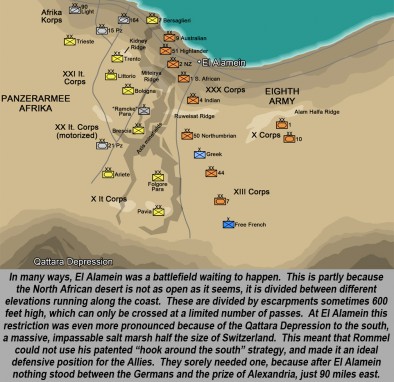
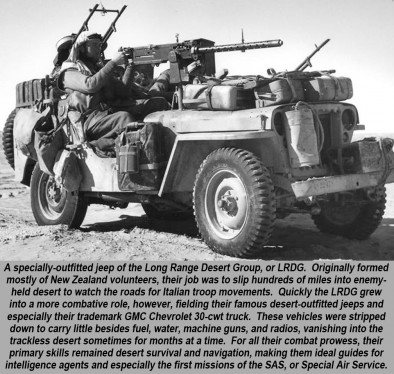

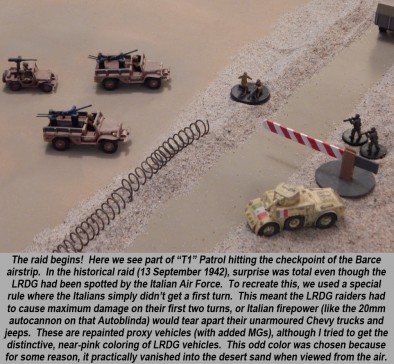

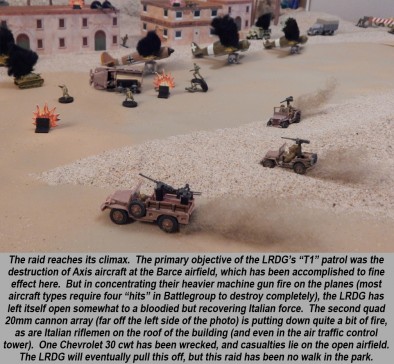
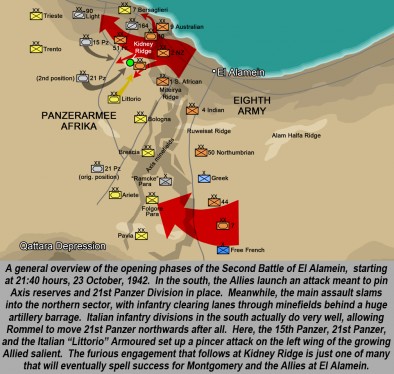
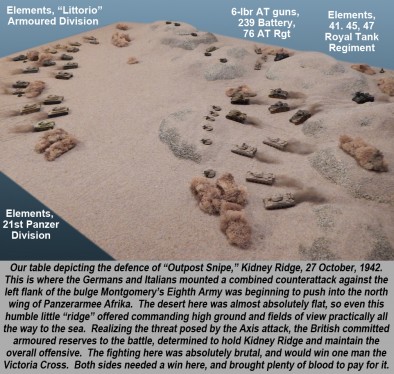
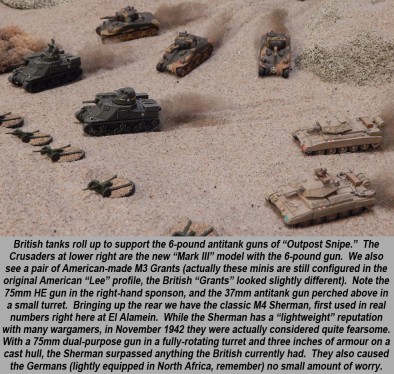
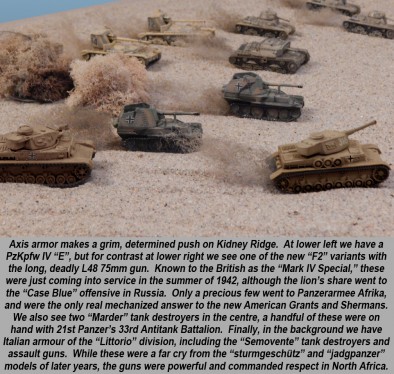
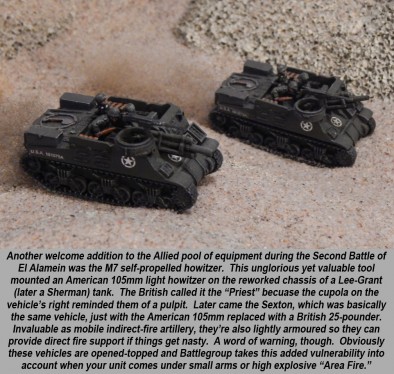




























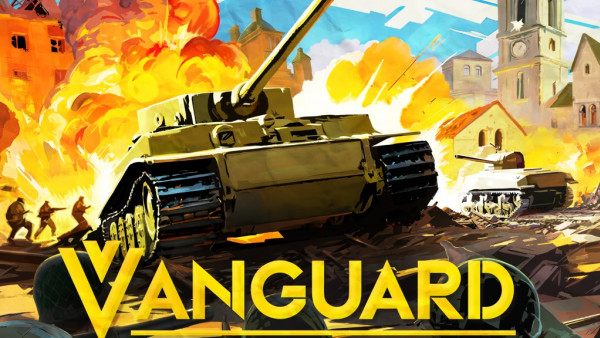

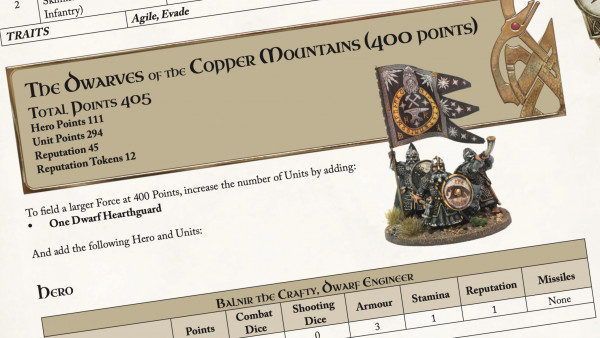




im loving this series!
Gah I do love these battle scenes – reminds me why I love the spectacle of wargaming so much.
Great miniatures + great terrain = awesome.
BoW Ben
Thanks very much @sebcranston and @brennon . . . although I might add one more factor to Ben’s equation . . . Minis + Terrain + Great Feedback from Fellow Gamers = Awesome! Thanks again! 😀
Well, Lloyd was right, the terrain just keeps getting better and better. Sometimes I can’t appreciate it as much while the game is going on. But seeing it cleaned up, well lit, and zoomed in really highlights all the detail you put into the board. It almost makes all the sand on the floor worth while 😉
As awesome as the rest! I hope you are going to do more of these. I hope your missus hates sand everywhere just like mine…
Thanks, @unclejimmy ! We have one more article in this series, and then a few more ideas for the next series in October or November. Actually spending a little time today taking down all this sand table stuff . . . sadly I don’t have a “studio” or spare room where I can leave gaming tables up indefinitely. 🙁
Loving the series, adoring the scenery.
One nit-pick – the Panzer IV F2 carried the L43 gun – the L48 with the double baffle muzzle brake did not appear until April 1943.
See, I thought that was a misprint in the book You’re right,of course. Thanks! You must be talking about the G or H (I think G had the turret spaced armor, H had the full schurzen?)
UH @oriskany this one was tough. Great stuff as usual. If I just could express my opinion I would add that not only were the German supply lines outstretched but also the supply was not arriving to Africa because of the ship loses and the units at the back (as always) kept a lot of it for themselves. While Montgomery was really sneaky his plan to lure the Germans to the South were an improvised attack (I like the part about the preparations – paper tanks, false pipeline, pre-recorded radio messages) by the XIII Corps did not work and in… Read more »
Thanks very much, @yavasa , and please never hesitate to bring up opinions, additional facts, or even corrections. Lord knows I need them now and again. 🙂 Indeed I have read something about up to 60% of Axis supplies that arrived in Africa were being consumed by logistical efforts or rear-echelon forces. I don’t have the exact figures or the source off the top of my head, but it was definitely a lot. For every gallon of fuel that might have reached Panzerarmee Afrika by this point, it took two gallons of fuel to carry it there. PLUS, (as you… Read more »
Great read – again
Thanks @rasmus ! Four down, one to go! 😀
Just to note the Panzer IV ‘special’ or Ausf F2 (actually redesignated ausf G) had the L 43 75 mm gun, not the L 48, which was not fitted till later in the war.
Indeed the L43 was the correct gun, @piers – although it looks like @dorthonion “ninja-ed” in before you with the correction. 😀
Yer… sorry. Didn’t see that!
Trust me, I wish I’d “seen” it before I published the article. I knew the F2 had a different 7.5 cm gun, simply by the “Firefly-esque” tulip-shaped muzzle brake. I just never realized it was a different length.
Great articles, great tables, great models, just the great final to go @oriskany
Thanks, @zorg . . . and yep, just one more to go. That last part will focus on Tunisia, when the Americans (and some Tigers) finally make their debut. 🙂
So wait a second. The article says the long rangde desert guys had to go 1000+ miles to get to the airfield, then some of them had to walk home? You’re not telling us they had to walk 1000 miles through the desert, I’m assuming. 🙂
No, @gladesrunner , just back to rendezvous points. Much closer to the target, they’d set up hidden spots in the desert where they’d stage extra fuel, medical supplies, water, maybe even an extra vehicle, etc. Also, the LRDG force had split into more than one force to attack more than one target (the barracks and the airfield). Once everyone made it back to the rendezvous point, the guys who’d had to walk I’m sure could catch a ride with someone. 🙂 But just getting back to the rendezvous point was an Hollywood movie-level endurance point in itself, especially with Italian… Read more »
Excellent as usual! That last battle looked really fun, ‘hold at all costs’ scenario’s can really give great games!
I’ll have to pick up the pace on my Normandy collection so I can start with North Africa!
Looking forward to Kasserine!
Thanks, @neves1789 . I admit I really like really big mash-ups like this once in a while. But in Battlegroup, once you get a battle that size we usually discuss beforehand what aspects of the rules we’re going to drop – just to keep the game manageable In this case, for example, one of the things we dropped was tracking ammunition per unit. We kept one exception with those really big Semovente 90mm SP ATGs. Very powerful guns (practically German 88s), but the only carried 6 shells historically (yielding an ammo value of “1” in Battlegroup I think). So the… Read more »
Great series of articles. If it was stated I missed it; who won your Battle of Kidney Ridge?
Thanks, @lorddgort – You didn’t miss anything, I kind of “wrote around that” particular point because the actual tabletop results were a little unclear. Please bear in mind that because “Battlegroup” doesn’t have a North Africa book (yet), a lot of the games in this series were based on house rules, usually taken from games that DO have desert scenarios / terrain rules (such as Panzer Leader). Part of this was (as stated) some “off the cuff” victory conditions on this one. Anyway, on Turn 6 or 7, the Germans made a last determined shove at the terrain spot we… Read more »
Great article! You’ve reached the point in the campaign where my BA armies fit in so its especially interesting to me
Thanks, @koraski . Yeah, El Alamein and forward is where a lot of wargamers like to research, build, and play. More armies, more nationalities, and better equipment (even the Italians get some pretty decent assault guns and armoured cars 🙂 ). The Americans are in soon, the Vichy French, etc. Which reminds me, @neves1789 . . .I’m terribly sorry but we actually skip over Kasserine in Part V. 🙁 I figured anyone who’s seen the movie “Patton” knows about Kasserine and the redemption at El Guettar. So I picked something else for the American debut. I’ll be sure to put… Read more »
I chose based on what I can get in plastic. That’s the prime factor in my decision for theatre and army selection. So far only the armored cars are resin. Everything else I have found plastic kits for.
Gotta agree with that. I get plastic whenever I can. Perhaps I’ve just had bad luck, but a lot of my metal miniatures (from various manufacturers) don’t seem to fit together, and the mold lines are always tough to get rid of. As for resin, its often arrived chipped or outright broken. I’ve had to rebuild running boards, tracks, mudguards, etc.
Great read as I have come to expect 🙂 Others have already covered the points that I would have raised. I did get a hold of a copy of Battlegroups core rules and I like what I read. While I also prefer plastic for this time period sometimes you do not have a lot of choices.
Thanks once again, @tibour – There are definitely a lot of things I like about the Battlegroup system (as I’ve brought up before), so I hope you enjoy it as much as I have, though. If you don’t have any of of the source books, Battlegroup Kursk is probably a good place to start as it’s available .pdf on the PSC site. In particular, I had a HELL of a time finding Crusaders (albeit this is about a year ago), and you need Crusaders to do the Desert War any kind of justice. 🙂 I finally wound up with some… Read more »
James please give some serious thought to publishing this?
It’s so well written and accessible that I would happily buy it !
On another note, you mention “Montgomery’s better traits was that he would not be pushed around by Churchill”
Was it this same trait confused by Patton as ‘indecisiveness’ or lack of ‘action’.
Now see, @lateo , I thought I HAD published it, right here on Beasts of War. 🙂 (cue corny sound effect for failed joke). Seriously, though, thanks very much. What I was talking about re: Monty not letting himself be pushed around by Churchill was this: Previous commanders (Wavell, Auchinleck, Ritchie) were many times rushed into launching attacks like Brevity, Battleaxe, and Crusader before they were ready. The generals KNEW they weren’t ready. Yet Churchill, keen on showing Stalin and Roosevelt that the British were doing SOMETHING in ‘41 and ‘42, and also to keep up morale at home, exerted… Read more »
Sweet….
Thank you, sir! 😀
what a fantastic read again mate , thank you!
A really great read again thanks